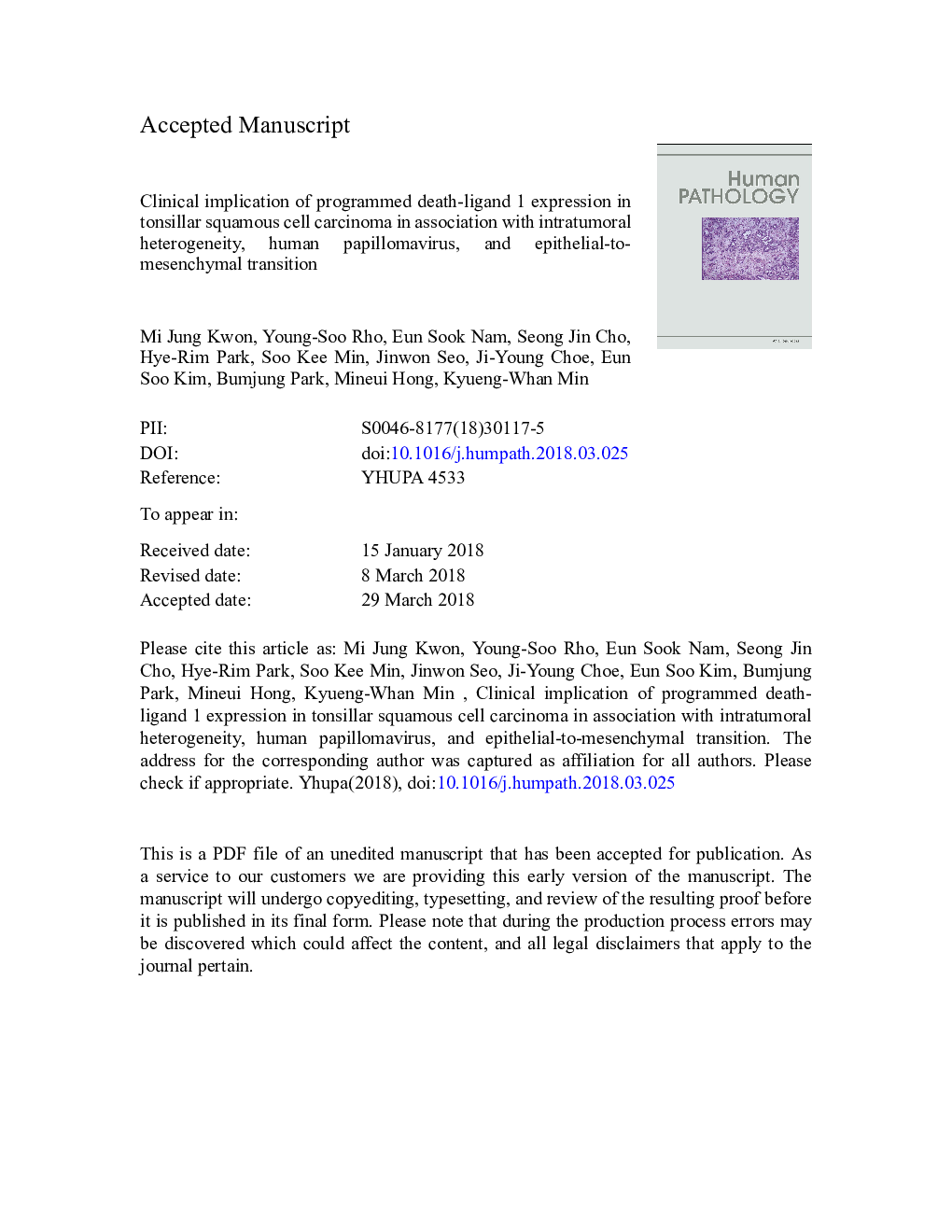| کد مقاله | کد نشریه | سال انتشار | مقاله انگلیسی | نسخه تمام متن |
|---|---|---|---|---|
| 8807430 | 1606630 | 2018 | 26 صفحه PDF | دانلود رایگان |
عنوان انگلیسی مقاله ISI
Clinical implication of programmed cell death-1 ligand-1 expression in tonsillar squamous cell carcinoma in association with intratumoral heterogeneity, human papillomavirus, and epithelial-to-mesenchymal transition
دانلود مقاله + سفارش ترجمه
دانلود مقاله ISI انگلیسی
رایگان برای ایرانیان
کلمات کلیدی
موضوعات مرتبط
علوم پزشکی و سلامت
پزشکی و دندانپزشکی
آسیبشناسی و فناوری پزشکی
پیش نمایش صفحه اول مقاله

چکیده انگلیسی
Programmed cell death-1 ligand-1 (PD-L1), essential for immune evasion, is a potential candidate for pathogenesis and therapeutic target of human papillomavirus (HPV)-positive tonsillar squamous cell carcinomas (TSCCs). MET/hepatocyte growth factor signaling and transcription factors involved in epithelial-to-mesenchymal transition (EMT) upregulate PD-L1, which can contribute to clinical outcome. Intratumoral heterogeneity of PD-L1 expression is of clinical importance in selection bias due to false-negative patient enrollment. However, the clinicopathological features, prognostic value, and coexpressed molecules of PD-L1 remain unclear in TSCCs. PD-L1 expression was evaluated via immunohistochemistry using a specific monoclonal antibody (SP142) between whole-tissue and tissue microarray (TMA) sections of 79 tumors (5% cutoff value with weak staining). Expressions of EMT markers (TWIST1, Snail, and SNIP1) and MET/hepatocyte growth factor were also analyzed. Staining of the TMA sections showed 78.5% concordance rate to the whole section. PD-L1 positivity and its intratumoral heterogeneity were 29.1% and 15.2% of TSCCs by whole section, respectively. PD-L1 positivity was prevalent in females, HPV-positive tumors without base of tongue invasion, and SNIP1-overexpressed tumors. SNIP1 overexpression, unmethylated TWIST1, smoking, and poorly differentiated tumors were predictive for PD-L1 overexpression. PD-L1 positivity was a favorable independent prognostic factor. Subgroup analyses according to the coexpression of PD-L1 with HPV, SNIP1, or unmethylated TWIST1 indicated the best clinical outcome than any other subgroups. In conclusion, intratumoral heterogeneity of PD-L1 expression was frequent, warranting a caution in punching TMA cores. A combined analysis of PD-L1 with EMT and HPV may define a characteristic subset of patients and prognostic group.
ناشر
Database: Elsevier - ScienceDirect (ساینس دایرکت)
Journal: Human Pathology - Volume 80, October 2018, Pages 28-39
Journal: Human Pathology - Volume 80, October 2018, Pages 28-39
نویسندگان
Mi Jung MD, PhD, Young-Soo MD, PhD, Eun Sook MD, PhD, Seong Jin MD, PhD, Hye-Rim MD, PhD, Soo Kee MD, PhD, Jinwon MD, Ji-Young MD, PhD, Eun Soo MD, PhD, Bumjung MD, PhD, Mineui MD, PhD, Kyueng-Whan MD, PhD,